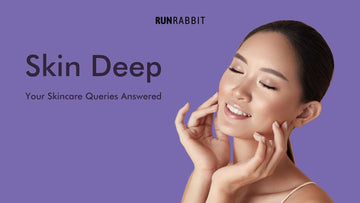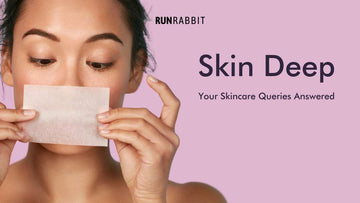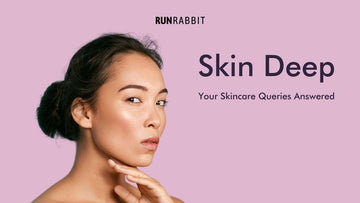Skin Deep blog series is for you who have a multitude of queries regarding skincare but are still hesitant to ask another person. We are ready to answer the most common skincare-related questions asked by you! Are you ready?
SKINCARE QUERY NO.1
"HOW CAN I DETERMINE MY SKIN TYPE?"
To tell you the truth I was in a huge but not so huge confusion a long time back not knowing what my skin type was. Just like many other questions we come across this question too had a big BUT. So I had a huge confusion regarding my skin type BUT it was not a question without an answer. And this is how I unlocked the mystery of skin type.

It's easier than you might think! I have THREE answers for your not-so-confusing question in the form of THREE METHODS.
1. The "bare-faced" method
It all starts by washing your face with a gentle cleanser and patting it dry. Wait for about an hour, allowing your skin to return to its natural state.
Now, all that it takes is a closer look at your skin. Now, now here c omes another question. Does it feel tight, dry, or flaky? If so, you likely have dry skin. On the other hand, if you notice shine on your forehead, nose, and chin (the T-zone), you might have oily skin. Combination skin is common, where some parts of your face are oily (like the T-zone) while others are dry. If your skin feels comfortable without any extreme dryness or oiliness, you likely have normal skin.
omes another question. Does it feel tight, dry, or flaky? If so, you likely have dry skin. On the other hand, if you notice shine on your forehead, nose, and chin (the T-zone), you might have oily skin. Combination skin is common, where some parts of your face are oily (like the T-zone) while others are dry. If your skin feels comfortable without any extreme dryness or oiliness, you likely have normal skin.
Remember, your skin type can change over time due to various factors like weather, hormones, or skincare products. So, it's essential to listen to your skin.
2. The Three Finger Theory
The three-finger theory is a quick and easy way to determine your skin type. Here's how it works,
First it requires a little bit of touch. With clean hands, gently touch your forehead, nose, and chin (the T-zone) with your fingertips. Second is undoubtedly to observe the feeling paying attention to how your skin feels after touching these areas. If your skin feels oily and there is a noticeable residue on your fingertips, you likely have oily skin. If your skin feels dry or tight, especially after washing, you likely have dry skin. If your skin feels oily in the T-zone but normal or dry on the cheeks, you may have combination skin. If your skin feels comfortable without any extreme dryness or oiliness, you likely have normal skin.
3. The Face Mapping Method
How does this work? So this is based on the belief that different areas of your skin has a specific indication of what your skin type is.
| Forehead (T-zone) | Cheeks | Neck area |
 If your forehead tends to be oily, shiny, or prone to acne, it may indicate that you have oily skin. The T-zone, which includes the forehead, nose, and chin, is typically oilier than the rest of the# |
Dry or flaky skin on the cheeks may indicate dry skin. If the cheeks feel comfortable and not oily or dry, it may indicate normal skin. |
|
Once you unlock this mystery of you skin type deciding on the perfect skincare routine is not at all a mission impossible. Once you unleash your skin type you can decide on your skincare routine to suit your specific needs and achieve that healthy, glowing complexion you've always wanted! It often requires a skincare routine that addresses your skin type, be it dry, oily, combination or normal, it's essential to use products that suits your skin type, such as a gentle cleanser, lightweight moisturizer, and targeted treatments for specific areas.
And you obviously know where to find the perfect products to perfect your skin routine.
"UNLEASH THE TRUTH BEHIND YOUR SKIN AND EMBRACE A PERSONALIZED SKINCARE ROUTINE"
Explore more skincare tips and answers to your burning skincare question No. 2 brought to you by the Skin Deep Blog Series!






















 The skin on the neck is often similar to the skin on the face, but it can vary. If the skin on your neck feels similar to your cheeks (dry or normal), it may support the idea of combination skin.
The skin on the neck is often similar to the skin on the face, but it can vary. If the skin on your neck feels similar to your cheeks (dry or normal), it may support the idea of combination skin.
